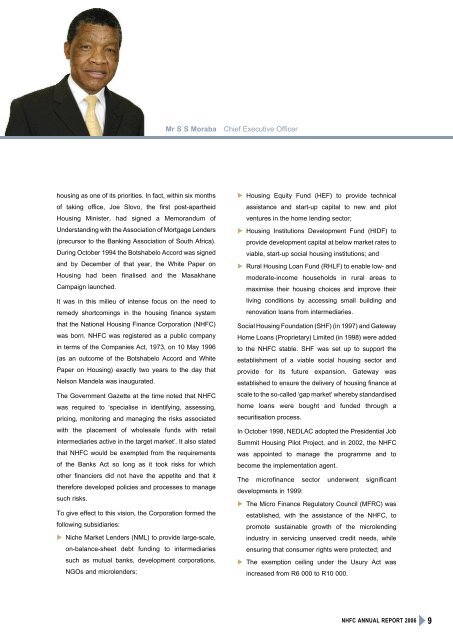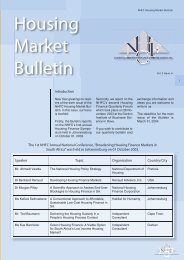housing - National Housing Finance Corporation
housing - National Housing Finance Corporation
housing - National Housing Finance Corporation
Create successful ePaper yourself
Turn your PDF publications into a flip-book with our unique Google optimized e-Paper software.
Mr S S Moraba Chief Executive Officer<br />
<strong>housing</strong> as one of its priorities. In fact, within six months<br />
of taking office, Joe Slovo, the first post-apartheid<br />
<strong>Housing</strong> Minister, had signed a Memorandum of<br />
Understanding with the Association of Mortgage Lenders<br />
(precursor to the Banking Association of South Africa).<br />
During October 1994 the Botshabelo Accord was signed<br />
and by December of that year, the White Paper on<br />
<strong>Housing</strong> had been finalised and the Masakhane<br />
Campaign launched.<br />
It was in this milieu of intense focus on the need to<br />
remedy shortcomings in the <strong>housing</strong> finance system<br />
that the <strong>National</strong> <strong>Housing</strong> <strong>Finance</strong> <strong>Corporation</strong> (NHFC)<br />
was born. NHFC was registered as a public company<br />
in terms of the Companies Act, 1973, on 10 May 1996<br />
(as an outcome of the Botshabelo Accord and White<br />
Paper on <strong>Housing</strong>) exactly two years to the day that<br />
Nelson Mandela was inaugurated.<br />
The Government Gazette at the time noted that NHFC<br />
was required to ‘specialise in identifying, assessing,<br />
pricing, monitoring and managing the risks associated<br />
with the placement of wholesale funds with retail<br />
intermediaries active in the target market’. It also stated<br />
that NHFC would be exempted from the requirements<br />
of the Banks Act so long as it took risks for which<br />
other financiers did not have the appetite and that it<br />
therefore developed policies and processes to manage<br />
such risks.<br />
To give effect to this vision, the <strong>Corporation</strong> formed the<br />
following subsidiaries:<br />
u Niche Market Lenders (NML) to provide large-scale,<br />
on-balance-sheet debt funding to intermediaries<br />
such as mutual banks, development corporations,<br />
NGOs and microlenders;<br />
u <strong>Housing</strong> Equity Fund (HEF) to provide technical<br />
assistance and start-up capital to new and pilot<br />
ventures in the home lending sector;<br />
u <strong>Housing</strong> Institutions Development Fund (HIDF) to<br />
provide development capital at below market rates to<br />
viable, start-up social <strong>housing</strong> institutions; and<br />
u Rural <strong>Housing</strong> Loan Fund (RHLF) to enable low- and<br />
moderate-income households in rural areas to<br />
maximise their <strong>housing</strong> choices and improve their<br />
living conditions by accessing small building and<br />
renovation loans from intermediaries.<br />
Social <strong>Housing</strong> Foundation (SHF) (in 1997) and Gateway<br />
Home Loans (Proprietary) Limited (in 1998) were added<br />
to the NHFC stable. SHF was set up to support the<br />
establishment of a viable social <strong>housing</strong> sector and<br />
provide for its future expansion. Gateway was<br />
established to ensure the delivery of <strong>housing</strong> finance at<br />
scale to the so-called ‘gap market’ whereby standardised<br />
home loans were bought and funded through a<br />
securitisation process.<br />
In October 1998, NEDLAC adopted the Presidential Job<br />
Summit <strong>Housing</strong> Pilot Project, and in 2002, the NHFC<br />
was appointed to manage the programme and to<br />
become the implementation agent.<br />
The microfinance sector underwent significant<br />
developments in 1999:<br />
u The Micro <strong>Finance</strong> Regulatory Council (MFRC) was<br />
established, with the assistance of the NHFC, to<br />
promote sustainable growth of the microlending<br />
industry in servicing unserved credit needs, while<br />
ensuring that consumer rights were protected; and<br />
u The exemption ceiling under the Usury Act was<br />
increased from R6 000 to R10 000.<br />
NHFC ANNUAL REPORT 2006 9






